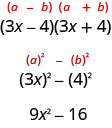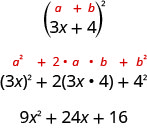4.3: Factor Special Products
( \newcommand{\kernel}{\mathrm{null}\,}\)
By the end of this section, you will be able to:
- Factor perfect square trinomials
- Factor differences of squares
- Factor sums and differences of cubes
Before you get started, take this readiness quiz.
1. Simplify: (3x2)3.
2. Multiply: (m+4)2.
3. Multiply: (x−3)(x+3).
We have seen that some binomials and trinomials result from special products—squaring binomials and multiplying conjugates. If we recognize these kinds of polynomials, we can use the special products patterns to factor them much more quickly.
Factor Differences of Squares
One special product we are familiar with is the Product of Conjugates pattern. We use this to multiply two binomials that were conjugates. Here’s an example:

A difference of squares factors to a product of conjugates (in this context, a−b is said to be conjugate to a+b, and vice versa.)
If a and b are real numbers,

Remember, “difference” refers to subtraction. So, to use this pattern we must make sure we have a binomial in which two squares are being subtracted.
Factor 64y2−1.
- Solution
-




Factor 121m2−1.
- Answer
-
(11m−1)(11m+1)
Factor 81y2−1.
- Answer
-
(9y−1)(9y+1)
Step 1.Does the binomial fit the pattern?a2−b2Is this a difference?____−____Are the first and last terms perfect squares?Step 2.Write them as squares.(a)2−(b)2Step 3.Write the product of conjugates.(a−b)(a+b)Step 4.Check by multiplying.
It is important to remember that sums of squares do not factor into a product of binomials. There are no binomial factors that multiply together to get a sum of squares. After removing any GCF, the expression a2+b2 can not be factored any further!
The next example shows variables in both terms.
Factor 144x2−49y2.
- Solution
-
144x2−49y2Is this a difference of squares? Yes.(12x)2−(7y)2Factor as the product of conjugates.(12x−7y)(12x+7y)Check by multiplying.(12x−7y)(12x+7y)Check by multiplying.(12x−7y)(12x+7y)144x2−49y2✓
Factor 196m2−25n2.
- Answer
-
(16m−5n)(16m+5n)
Factor 121p2−9q2.
- Answer
-
(11p−3q)(11p+3q)
As always, we should look for a common factor first whenever we have an expression to factor. Sometimes a common factor may “disguise” the difference of squares and we won’t recognize the perfect squares until we factor the GCF.
Also, to completely factor the binomial in the next example, we’ll factor a difference of squares twice!
Factor 48x4y2−243y2.
- Solution
-
48x4y2−243y2Is there a GCF? Yes, 3y2—factor it out!3y2(16x4−81)Is the binomial a difference of squares? Yes.3y2((4x2)2−(9)2)Factor as a product of conjugates.3y2(4x2−9)(4x2+9)Notice the first binomial is also a difference of squares!3y2((2x)2−(3)2)(4x2+9)Factor it as the product of conjugates.3y2(2x−3)(2x+3)(4x2+9)
The last factor, the sum of squares, cannot be factored.
Check by multiplying:3y2(2x−3)(2x+3)(4x2+9)3y2(4x2−9)(4x2+9)3y2(16x4−81)48x4y2−243y2✓
Factor 2x4y2−32y2.
- Answer
-
2y2(x−2)(x+2)(x2+4)
Factor 7a4c2−7b4c2.
- Answer
-
7c2(a−b)(a+b)(a2+b2)
The next example has a polynomial with 4 terms. So far, when this occurred we grouped the terms in twos and factored from there. Here we will notice that the first three terms form a perfect square trinomial.
Factor x2−6x+9−y2.
- Solution
-
Notice that the first three terms form a perfect square trinomial.
Factor by grouping the first three terms. Use the perfect square trinomial pattern. (x−3)2−y2 Is this a difference of squares? Yes. Yes—write them as squares. 
Factor as the product of conjugates. 
(x−3−y)(x−3+y) we may want to rewrite the solution as (x−y−3)(x+y−3).
Factor x2−10x+25−y2.
- Answer
-
(x−5−y)(x−5+y)
Factor x2+6x+9−4y2.
- Answer
-
(x+3−2y)(x+3+2y)
Factor Perfect Square Trinomials (optional discussion)
Some trinomials are perfect squares. They result from multiplying a binomial times itself. We squared a binomial using the Binomial Squares pattern in a previous chapter.

The trinomial 9x2+24x+16 is called a perfect square trinomial. It is the square of the binomial 3x+4.
In this chapter, we will start with a perfect square trinomial and factor it into its as many factors as possible. We could factor this trinomial using the methods described in the last section, since it is of the form ax2+bx+c. But if we recognize that the first and last terms are squares and the trinomial fits the perfect square trinomials pattern, we will save ourselves a lot of work. Here is the pattern—the reverse of the binomial squares pattern.
If a and b are real numbers
a2+2ab+b2=(a+b)2,
a2−2ab+b2=(a−b)2.
To make use of this pattern, we have to recognize that a given trinomial fits it. Check first to see if the leading coefficient is a perfect square, a2. Next check that the last term is a perfect square, b2. Then check the middle term—is it the product, 2ab? If everything checks, we can easily write the factors.
The sign of the middle term determines which pattern we will use. When the middle term is negative, we use the pattern a2−2ab+b2, which factors to (a−b)2.
The steps are summarized here.
Step 1.Does the trinomial fit the pattern?a2+2ab+b2a2−2ab+b2Are the first and last terms perfect squares?Write them as squares.(a)2(b)2(a)2(b)2Check the middle term. Is it 2ab?↘2·a·b↙↘2·a·b↙Step 2.Write the square of the binomial.(a+b)2(a−b)2Step 3.Check by multiplying.
Remember the first step in factoring is to look for a greatest common factor. Perfect square trinomials may have a GCF in all three terms and it should be factored out first. And, sometimes, once the GCF has been factored, we will recognize a perfect square trinomial.
The above is for consideration, but we will not give any examples of this here.
Key Concepts
- Difference of Squares Pattern: If a, b are real numbers,

- How to factor differences of squares
Step 1.Does the binomial fit the pattern?a2−b2Is this a difference?____−____Are the first and last terms perfect squares?Step 2.Write them as squares.(a)2−(b)2Step 3.Write the product of conjugates.(a−b)(a+b)Step 4.Check by multiplying. - Perfect Square Trinomials Pattern: If a and b are real numbers,
a2+2ab+b2=(a+b)2a2−2ab+b2=(a−b)2
- How to factor perfect square trinomials
Step 1.Does the trinomial fit the pattern?a2+2ab+b2a2−2ab+b2Are the first and last terms perfect squares?Write them as squares.(a)2(b)2(a)2(b)2Check the middle term. Is it 2ab?↘2·a·b↙↘2·a·b↙Step 2.Write the square of the binomial.(a+b)2(a−b)2Step 3.Check by multiplying.
Practice Makes Perfect
Factor Differences of Squares
In the following exercises, factor completely using the difference of squares pattern, if possible.
1. 25v2−1
- Answer
-
(5v−1)(5v+1)
2. 169q2−1
3. 4−49x2
- Answer
-
(7x−2)(7x+2)
4. 121−25s2
5. 6p2q2−54p2
- Answer
-
6p2(q−3)(q+3)
6. 98r3−72r
7. 24p2+54
- Answer
-
6(4p2+9)
8. 20b2+140
9. 121x2−144y2
- Answer
-
(11x−12y)(11x+12y)
10. 49x2−81y2
11. 169c2−36d2
- Answer
-
(13c−6d)(13c+6d)
12. 36p2−49q2
13. 16z4−1
- Answer
-
(2z−1)(2z+1)(4z2+1)
14. m4−n4
15. 162a4b2−32b2
- Answer
-
2b2(3a−2)(3a+2)(9a2+4)
16. 48m4n2−243n2
17. x2−16x+64−y2
- Answer
-
(x−8−y)(x−8+y)
18. p2+14p+49−q2
19. a2+6a+9−9b2
- Answer
-
(a+3−3b)(a+3+3b)
20. m2−6m+9−16n2
Factor Perfect Square Trinomials
In the following exercises, factor completely using the perfect square trinomials pattern.
21. 16y2+24y+9
- Answer
-
(4y+3)2
22. 25v2+20v+4
23. 36s2+84s+49
- Answer
-
(6s+7)2
24. 49s2+154s+121
25. 100x2−20x+1
- Answer
-
(10x−1)2
26. 64z2−16z+1
27. 25n2−120n+144
- Answer
-
(5n−12)2
28. 4p2−52p+169
29. 49x2+28xy+4y2
- Answer
-
(7x+2y)2
30. 25r2+60rs+36s2
31. 100y2−52y+1
- Answer
-
(50y−1)(2y−1)
32. 64m2−34m+1
33. 10jk2+80jk+160j
- Answer
-
10j(k+4)2
34. 64x2y−96xy+36y
35. 75u4−30u3v+3u2v2
- Answer
-
3u2(5u−v)2
36. 90p4+300p4q+250p2q2
Mixed Practice
In the following exercises, factor completely.
37. 64a2−25
- Answer
-
(8a−5)(8a+5)
38. 121x2−144
39. 27q2−3
- Answer
-
3(3q−1)(3q+1)
40. 4p2−100
41. 16x2−72x+81
- Answer
-
(4x−9)2
42. 36y2+12y+1
43. 8p2+2
- Answer
-
2(4p2+1)
44. 81x2+169
45. 45n2+60n+20
- Answer
-
5(3n+2)2
46. x2−10x+25−y2
- Answer
-
(x+y−5)(x−y−5)
47. x2+12x+36−y2
Writing Exercises
48. Why was it important to practice using the binomial squares pattern in the chapter on multiplying polynomials?
- Answer
-
Answers will vary.
49. How do you recognize the binomial squares pattern?
50. Explain why n2+25≠(n+5)2. Use algebra, words, or pictures.
- Answer
-
Answers will vary.
51. Maribel factored y2−30y+81 as (y−9)2. Was she right or wrong? How do you know?
Self Check
a. After completing the exercises, use this checklist to evaluate your mastery of the objectives of this section.
b. What does this checklist tell you about your mastery of this section? What steps will you take to improve?


